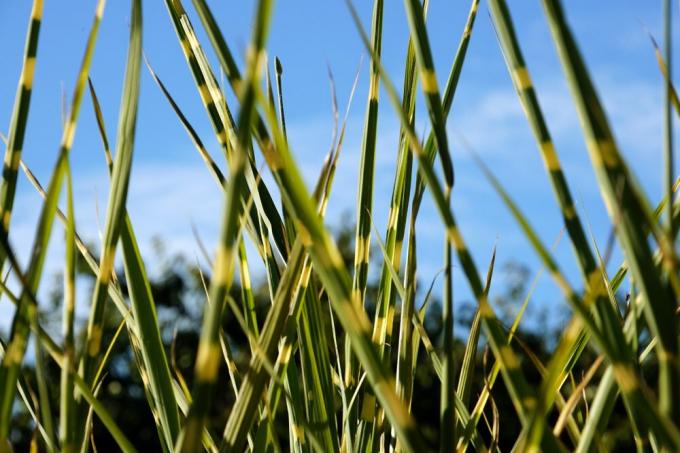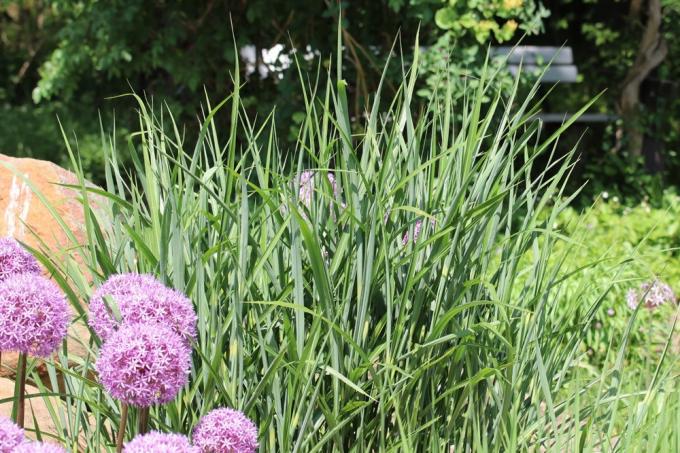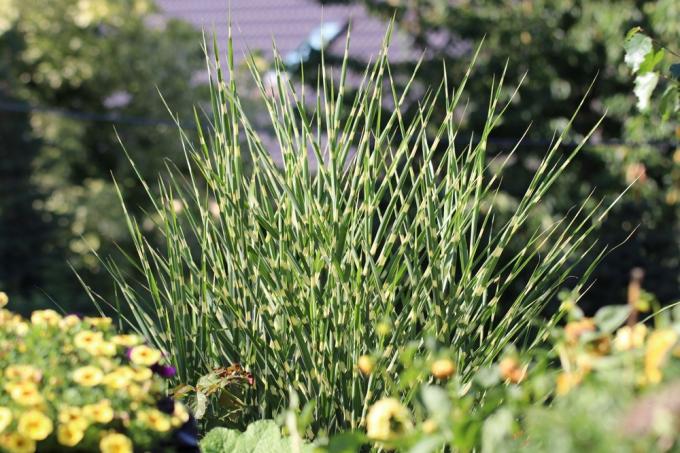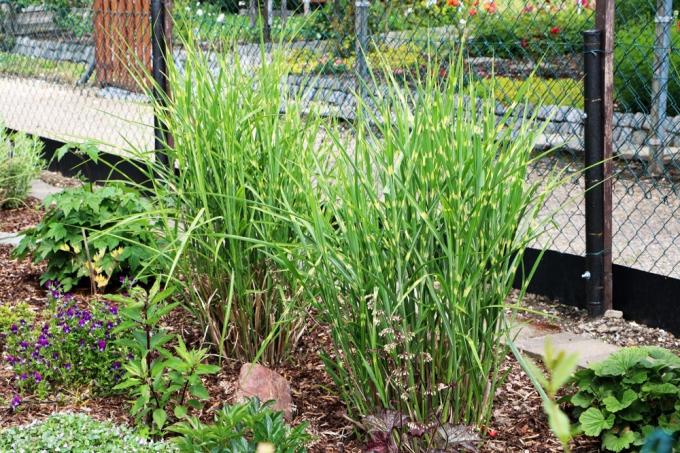
table of contents
- Characteristics
- care
- Location
- plants
- to water
- Fertilize
- Overwinter
- Cut
- Multiply
- sorts
Profile and care information open +conclude -
- Flower color
- White
- Location
- Partial shade, sunny, full sun
- Heyday
- August September October
- Growth habit
- upright, bushy, clump-forming, overhanging
- height
- 80 to 400 cm
- Soil type
- sandy, loamy
- Soil moisture
- moderately moist, fresh
- PH value
- neutral, weakly alkaline, weakly acidic
- Limescale tolerance
- Calcium tolerant
- humus
- rich in humus
- Poisonous
- no
- Plant families
- Sweet grasses, Poaceae
- Plant species
- Ornamental grasses
- Garden style
- Residential garden, ornamental garden
Among the ornamental grasses, Chinese reed with its diverse varieties is highly valued in the garden. With its majestic silhouette, the vigorous Miscanthus sinensis acts as a structuring agent and decorative counterpoint to colorful flowering perennials. Declared as undemanding, the cultivation of Chinese grass nevertheless requires the observance of important precautions. These care instructions show in a practical way how you can integrate the Asian sweet grass perfectly into your garden design.
Characteristics
- Plant family of the sweet grasses (Poaceae)
- popular type: Chinese reed (Miscanthus sinensis)
- popular variety: Zebra grass (Miscanthus sinensis 'Zebrinus')
- native to China, Japan and Korea
- perennial, reed-like ornamental grass
- Heights of growth from 80 to 400 cm
- stiffly upright, often broadly spreading habitus
- Numerous varieties with partly colored stems
- Panicle-shaped or feathery flower spikes in autumn
- invasive urge to spread via strong rhizomes and numerous seeds
- Usage scenarios: solitary, structure builder, privacy screen, pond planting, container plant
With a monumental stature, feathery flower panicles and a wonderful winter aspect, Chinese reed dominates the appearance in the garden. The towering ornamental grass inspires as a stylish solitaire, decorative companion to colorful flowering perennials or opaque privacy screens. The wide range of species also offers creative hobby gardeners small magnificent grasses that transform the balcony and terrace into a green refuge in the tub.

If a large or small garden threatens to freeze in formal beauty, the multi-faceted species and varieties of Miscanthus sinensis spread an aura of wild naturalness in every season. How to properly care for the mighty Chinese grass, the distinctive zebra grass and other conspecifics, these instructions convey in all details.
While Chinese reed is mainly used as an ornamental plant in Europe, it is still used in its countries of origin as a raw material for the manufacture of wicker products such as mats and baskets. In addition, the sweet grass stalks serve as a forage plant.
care
The successful cultivation of Chinese reed is based on a network of care measures that are coordinated with one another. It is not enough to locate the ornamental grass in the best possible location if the water and nutrient supply is neglected.
Furthermore, you will only enjoy the powerful Miscanthus sinensis if you have already put the aggressive urge to spread in place while planting. Last but not least, a skilful cut at the right time contributes significantly to the fact that a Chinese grass thrives vital and healthy. With this in mind, it is worthwhile to study the following details.
Location
Since the middle of the 20th Century found its way into the ornamental gardens of Europe, a well-founded wealth of experience has accumulated with regard to the ideal location conditions for the best growth. The tolerance towards light, wind and temperature conditions is positive.
Chinese grass thrives in these locations without any problems:
- sunny to partially shaded location
- light shade is acceptable with restrictions on color intensity and abundance of flowers
- high flexibility in relation to wind exposure
With its strong stalks, Chinese reeds are unimpressed by strong winds. The filigree zebra grass, on the other hand, favors a sheltered location so that it does not stand completely disheveled after an autumn storm. Furthermore, the eye-catching drawing of the stalks with yellow horizontal stripes only really comes into their own in full sun.

Substrate
It is no coincidence that Chinese reeds can often be admired in large parks and botanical gardens in close proximity to bodies of water. The sweet grass prefers constant soil moisture in order to achieve its optimum. Nevertheless, Chinese grass is quite adaptable in terms of soil quality, as the following overview shows.
- nutrient-rich, humus-rich and well-drained soil
- like fresh and moist to moderately dry
- ideally with a slightly acidic to moderately alkaline pH between 4.5 and 7.5
Dwarf varieties like to give a rendezvous in the tub on the balcony and terrace in a mix of loamy garden soil, compost, sand and fine grit.
plants
Planting time
In the schedule for this year's planting, your new Chinese reeds should be reserved for April. In the weeks before, the soil is still too cold for the young roots under normal weather conditions. For young plants grown in the container, the time window for planting remains open until early summer.
During dry, hot summer days, Chinese grass should not be planted in the ground, as the water requirement is significantly higher in the first few weeks than in the further course of growth.
Plant spacing
Please adjust the planting distance as precisely as possible to the selected species and variety. It is obvious that a mighty Chinese reed requires a greater distance to its neighbors than the more compact zebra grass or a dwarf variety. We have put together recommended planting distances for popular Chinese grass species for your guidance.
- Dwarf Chinese reed (plant height 100-150 cm): planting distance 80-100 cm
- Half-height Chinese reed (stature height 140-160 cm): planting distance 100-120 cm
- Zebra grass (plant height 160-250 cm): Plant distance 120-150 cm
- Chinese reed (stature height 250-300 cm): Plant distance 150-180 cm

This plant spacing is recommended when arranging Chinese grass in a group. In order for the mighty ornamental grass to stand out as a solitaire, the distance should be a little more generous.
Plants in the bed
Put the still potted root ball in water while you prepare the soil at the chosen location. Dig the soil 2 spades deep and remove all roots, stones and weeds. Then take the rake in hand to create the finest possible substrate for your Chinese reed.
How to proceed:
- dig a planting pit with twice the volume of the root ball
- Enrich the excavation in the wheelbarrow with leaf compost, horn shavings or bark humus
- Line the pit edges completely with a root barrier made of geotextile
- Position the potted root ball in the middle of the planting hole
- Fill in the soil-compost mixture so high that the previous planting depth is maintained
Finally, press the soil firmly and water it. A watering edge of 5-10 cm in height helps the plant to make optimal use of the available water.
Instead of a root barrier made of impenetrable geotextile, the plant pit can be lined with boards or stones along the edges. No gaps, no matter how small, should be created, as the powerful ornamental grass uses every gap as a breakthrough. Alternatively, put a Chinese reed in a bottomless concrete tub. It is important to note that any rhizome barrier protrudes a few centimeters from the soil so that the roots do not find their way into the garden.
Plants in the tub
Planting in beds and tubs is largely the same. The pot should have a minimum volume of 30 liters so that the extensive root system can expand sufficiently. An opening in the floor serves as a drain for excess irrigation and rainwater. In addition to planting beds, please create a drainage above the water drain.

Expanded clay balls, chippings or potsherds perform this task excellently. A water and air permeable fleece prevents the soil from silting up the drainage material. Only fill in the substrate so high that 5-6 cm remain free up to the edge of the vessel. Thanks to this precaution, no water can spill over.
to water
Chinaschilf wants a constantly moist soil without waterlogging. You should therefore water the ornamental grass regularly as soon as the soil has dried on the surface. Let the water from the hose or the can nozzle run onto the root area until small puddles indicate that the current requirement has been met.
For zebra grass in the bucket, this may be necessary in the morning on hot summer days and again in the evening. The excess water should then not remain in the coaster for more than 10-15 minutes. Please avoid overhead irrigation. On the one hand, too little water reaches the roots. On the other hand, damp stalks are a welcome target for fungal spores and other pathogens.
Fertilize
If you plant a Chinese reed in fertile soil enriched with compost according to these instructions, there is no need for fertilizer in the first year. In the second year you give the Chinese grass new momentum with compost and horn shavings in the spring. Until August / September you can promote vigor and willingness to flower by organically fertilizing every 4 weeks. This applies to both plants in the bed and in the tub.
Overwinter
Only late in the year do the feathery flower spikes rise above a Chinese reed. The creamy yellow to brownish inflorescences and seeds adorn the otherwise empty garden until well into winter. For this reason alone, the ornamental grass is not cut in autumn. In addition, the stalks protect the plant heart from moisture and cold.

How to properly overwinter Chinese grass:
- Tie Chinese reeds and zebra grass together with a sisal cord in autumn
- cover the root disc with autumn leaves or coniferous rice
- Do not fertilize any more from September
- water a little on mild winter days in the case of clear frost
Ideally, you should place a bucket under a roof overhang on a block of wood. Cover the vessel with jute or foil so that the root ball does not freeze through. The substrate is given a warming layer of peat dust, autumn leaves or brushwood.
Cut
At the end of winter you cut Chinese reeds close to the ground. The date should be chosen so early that no budding can be seen yet. Since the edges of the stalks are extremely sharp, please wear sturdy work gloves. Long-sleeved clothing is also useful, as the sap is phototoxic.
If your skin comes into contact with it when exposed to sunlight, unpleasant skin irritations are inevitable. Grasp the stalks in tufts to cut them off with a pair of scissors or a saw. Ideally, a chopper should be ready, as the clippings are ideal as mulch.
Multiply
There are several methods to choose from for breeding Chinese reeds. The vegetative propagation by division or with the help of root cuttings produces young plants with similar attributes as the mother plant. The result of the generative sowing of seeds, on the other hand, is uncertain until the budding or the first flowering. All 3 approaches are explained in more detail below.
division
If the ground is completely thawed in spring, dig up the cut back ornamental grass. Place the root ball on a stable surface to divide it into several segments. You will most likely only be able to cut an older Chinese grass with a saw.

Please note that a section will only take root again if it has at least 3 to 4 shoots. In the bright, sunny location, place the tapered Chinese grass at a suitable distance in the moist, compost-optimized soil. Water regularly and abundantly on the day itself and in the following weeks to encourage rooting.
Root cuttings
While the strong rhizomes with their vehement growth sometimes cause headaches, this property of Chinese reed has a positive side. A healthy, vital root strand has the life force for a new plant. So dig up one or more roots and cut them with a sharp cut of the spade.
Cut the rhizomes into pieces with at least 3 to 4 eyes. Put this 10-12 cm deep in the prepared soil at the new location and water. Compared to division, this variant of vegetative reproduction is somewhat slower, but it produces the same result.
sowing
So that sowing Chinese reed seeds does not turn into a guessing game about the result, we recommend purchasing certified seeds from specialist shops. In order to avoid the unpredictability of direct sowing, it is advisable to cultivate it on the windowsill. Sown in coconut fiber substrate, germination takes place at 20-25 degrees Celsius within 2 weeks.
After a further 6-8 weeks, the strongest seedlings can be pricked out. Keep the substrate slightly moist during this time. From the middle / end of April, a Chinese grass you have grown yourself can be planted as soon as the soil temperatures permanently exceed the 10-degree mark.

sorts
Chinaschilf offers a variety of varieties that leave no design wish unfulfilled. The following selection of successful breeds may serve for your inspiration.
Cosmopolitan
- the white Chinese reed inspires with green and white striped stalks and a towering stature
- this variety is ideally suited for a magnificent solitary in the middle of a sunny lawn
- Growth height 250-300 cm
bow
- Here the name of the variety says it all, given the elegantly curved, lush green stalks
- When the silvery flower spikes rise above the tuft of leaves in late summer, this premium ornamental grass attracts everyone's attention
- Growth height 170-200 cm
Strictus
- get to know a top class zebra grass here
- the stiffly upright stalks are covered with yellow horizontal stripes
- Since this hybrid has no tendency to overhang, it is aptly referred to as porcupine grass
- thus this variety is recommended for cultivation as a hedge
- Growth height 160-180 cm
adagio
- the richly blooming noble variety captivates with a harmonious habitus and compact density
- Adagio is therefore a good choice for the small garden, as well as for cultivation in large tubs
- Height 100-150 cm
